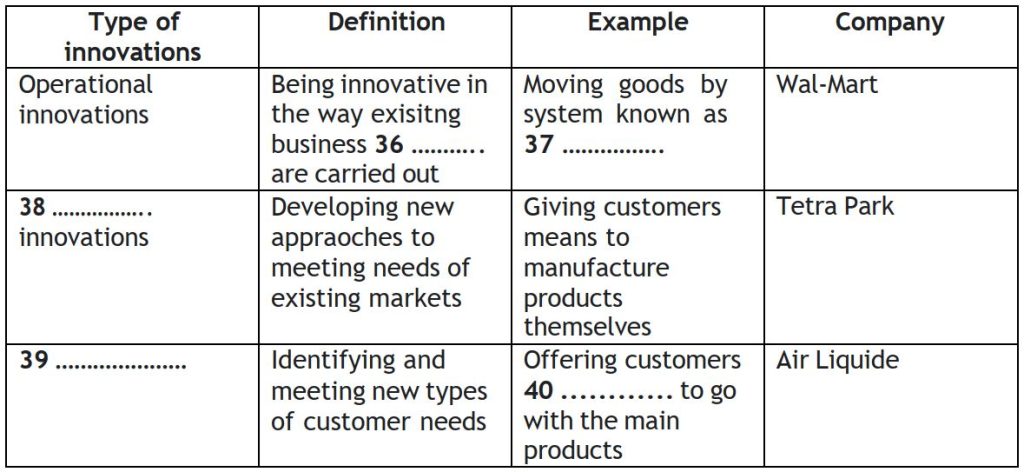PASSAGE 3 BUSINESS INNOVATION
26 تیر 1403 1403-08-12 15:16PASSAGE 3 BUSINESS INNOVATION
READING PASSAGE 3
You should spend about 20 minutes on Questions 27-40, which are based on Reading Passage 3 on pages 10 and 11.
BUSINESS INNOVATION
As new ‘wonder products’ are getting harder and harder to find, what should companies do to survive in today’s ever more competitive markets?
The Oxford English Dictionary defines innovation as ‘making changes to something established’. Invention, by contrast, is the act of ‘coming upon or finding; discovery’. Revolutionary ‘inventions’ of 20th-century US firms include, for example, the safety razor, the hydraulic brake, and DNA fingerprinting. However, as Adrian Slywotsky of Mercer Management Consulting says. ‘In most industries, truly differentiating new- product breakthroughs are becoming increasingly rare’. And as ‘blockbuster’ novel products become steadily more elusive, big companies would do well to focus instead on making lots of small things better.
Unfortunately, big companies often have big problems with innovation. ‘Innovators try to change the status quo’, says Bhaskar Chakravorti of the Monitor Group, ‘which is why markets tend to resist them”. Innovations frequently disrupt the way companies do things (and may have been doing them for years). And it is not just markets that are nervous of innovation. Michael Hammer, co-author of ‘Re-engineering the Corporation’, cites the case of a PC-maker that set out to imitate Dell’s famous ‘Build to Order’ system of computer assembly. The company found its attempts were frustrated by both its head of manufacturing, who feared for his job, and its head of marketing, who did not want to upset his existing retail outlets. So the proposal got nowhere, and Dell continued to dominate the business.
Clayton Christensen, a Harvard Business School Professor, describes how disruptive innovations – simpler, cheaper and more convenient products that seriously upset the stajus quo – often herald the rapid downfall of thriving, long-standing businesses. This, it is widely recognised, is because most such organisations are designed to grow through a series of sustaining innovations – the sort which simply improve on existing products for existing markets.
William Baumol, professor at New York • University, argues that large companies have been learning important lessons from the history of innovation. Most have bôth cut back and redirected their Research and Development spending in recent years.
Innovation by big companies is now based less on the discoveries of white-coated scientists, and more on incremental improvements in the processes that constitute daily operations.
According to marketing specialist Vijay Vishwanath, companies also need to adjust to the ongoing fragmentation of markets. Once-uniform mass markets are breaking up into countless ‘niches’, in whith everything has to be customised for a small group of consumers. Looking for blockbusters in such a world is a daunting task. Another problem, according to Chakravorti, lies in the marketing of innovations. Too many executives are still stuck with the strategies used to sell Kodak’s first camera 120 years ago, when the product was so revolutionary that the company could forget about competition for at least a decade. Today, rival products can be rushed onto the market at speeds which would have been unimaginable in those days.
Companies that fail to come up with headline-hitting new products should not despair. ‘There are plenty of other, albeit less glamorous, areas where innovation can take place, says Erik Brynjolfsson of the MIT Sloan School of Management. He claims that the roots of the USA’s productivity surge originate in ‘a genuine revolution in how American companies are using information technology to reinvent their business processes from top to bottom’.
Hammer highlights several instances where firms, have added considerably to their shareholder value through what he calls operational innovations – creativity in their business processes. Notable among these is the American retail giant Wal-Mart. While superficially mundane, their pioneering idea of ‘cross-docking – shifting merchandise off trucks from suppliers and straight onto trucks heading for stores – has been fundamental to the company’s ability to offer low prices, the platform for its outstanding success.
Companies are also being encouraged to embrace strategic innovations, following the example of such firms as Southwest Airlines, a low-cost American regional carrier, whose creative strategies and shrewd timing won it a victory over its ailing competitor US Airways. The Swedish packaging company Tetra Pak also used this style of innovation, by moving away from delivering ready-made containers for customers into providing machinery and supplying dedicated materials for them to make their own packaging. This strips out many costs from the process, and also makes it very diffigult for the customer to switch suppliers. Like Southwest Airlines, they achieved success through strategic innovations alone, with little innovation in either the underlying technology or the product sold.
In his book ‘How to Grow When Markets Don’t’, Slywotsky and his co-author Richard Wise recommend what they call demand innovations. A few far-sighted organisations such as the French industrial gas company Air Liquide have found success not – as in the case of strategic innovations – by meeting existing demand in a new way, but by discovering new forms of demand and adapting to supply the products or services required. Air Liquide had been areading supplier of industrial gases until the early 1990s, when gas became a commodity and their operational income plunged.
Realising the value of the skills they bad gained over the decades, the company became a supplier not only of gas, but also of the management services to accompany it. Within a short time their profits rose again.
There are certain things that manager can do to make innovations like these happen within their organisations. For example, projects with potential should be rapidly hived off into independent business units, away from the smothering influence of the status quo. The ultimate outcome of any one innovation may still be unpredictable, the process from which it emerges is not.
Questions 27-31
Do the following statements agree with the information given in Reading Passage 3? In boxes 27-31 on your answer sheet, write
YES if the statement agrees with the claims of the writer
NO if the statement contradicts the claims of the writer
NOT GIVEN if it is impossible to say what the writer thinks about this
27 In order to stay in the market, companies today need to concentrate their efforts on finding genuinely original products.
28 Disruptive innovations often pose serious threats to even successful, well- established companies.
29 A key stage in the development of sustaining innovations involves research into the strengths and weaknesses of competitors’ products.
30 Manufacturers today are able to compete with innovations over shorter time periods than in the past.
31 It is hard to tell what the long-term result of any innovation might be.
Questions 32-35
Look at the following points mentioned in the passage (Questions 32-35) and the list of people below.
Match each point with the correct person, A-E
Write the correct letter, A-E, in boxes 32-35 on your answer sheet.
32 The need for companies to cater for ever more specialised sets of customers
33 An explanation for the recent upward trend in the US economy
34 An example of company personnel who resisted innovation
35 A shift in the way many companies are organising their budgets
A Bhaskar Chakravorti
B Michael Hammer
C WiLlam Baumol
D Vijay Vishwanath
E Erik Brynjolfsson
Questions 36-40
Complete the table below.
Choose NO MORE THAN TWO WORDS from the passage for each answer. Write your answers in boxes 36-40 on your answer sheet.

27. NO – The passage says companies should focus on small improvements rather than completely new inventions (paragraph 1). “’In most industries, truly differentiating new- product breakthroughs are becoming increasingly rare’. And as ‘blockbuster’ novel products become steadily more elusive, big companies would do well to focus instead on making lots of small things better.”
28. YES – Disruptive innovations can lead to the downfall of established businesses (paragraph 3). “Clayton Christensen, a Harvard Business School Professor, describes how disruptive innovations – simpler, cheaper and more convenient products that seriously upset the status quo – often herald the rapid downfall of thriving, long-standing businesses.”
29. NOT GIVEN – The passage discusses sustaining innovations but doesn’t mention competitor analysis (paragraph 3). “it is widely recognised, is because most such organisations are designed to grow through a series of sustaining innovations – the sort which simply improve on existing products for existing markets.”
30. NOT GIVEN – While the implication is that the speed has increased, it’s not a clear statement about a shorter time frame for competition. (paragraph 5).
31. YES – The passage says the ultimate outcome of any innovation is unpredictable (paragraph 10). “The ultimate outcome of any one innovation may still be unpredictable, the process from which it emerges is not.”
32. D – Vijay Vishwanath discusses the fragmentation of markets (paragraph 5).
33. E – Erik Brynjolfsson attributes the US productivity surge to IT innovation (paragraph 6).
34. B – Michael Hammer gives the example of a PC maker where innovation was blocked (paragraph 2).
35. C – William Baumol says big companies have changed R&D spending (paragraph 4).
36. processes (paragraph 7) – Operational innovations focus on improving existing business processes.
37. cross-docking (paragraph 7) – This is an example of an operational innovation used by Wal-Mart.
38. Strategic (paragraph 8) – Strategic innovations involve new approaches to existing markets.
39. demand innovation (paragraph 9) – “In his book ‘How to Grow When Markets Don’t’, Slywotsky and his co-author Richard Wise recommend what they call demand innovations.”
40. management services (paragraph 9) – Air Liquide began offering management services in addition to gas.







